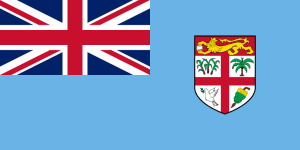
| Colors | HEX Code | RGB | CMYK |
|---|---|---|---|
| Cyan | #69B3E7 | 105, 179, 231 | 55, 23, 0, 9 |
| Blue | #012169 | 1, 33, 105 | 99, 69, 0, 59 |
| Red | #C8102E | 200, 16, 46 | 0, 92, 77, 22 |
| White | #FFFFFF | 255, 255, 255 | 0, 0, 0, 0 |
| Green | #00AD50 | 0, 173, 80 | 100, 0, 54, 32 |
| Yellow | #FEDD00 | 254, 221, 0 | 0, 13, 100, 0 |
| Brown | #852633 | 133, 38, 51 | 0, 71, 62, 48 |
Fiji is a country and archipelago in the South Pacific Ocean. Its flag has a dark blue field with a Union Jack in the canton, and the shield taken from the coat of arms is placed at the bottom fly end. The shield has the image of a heraldic lion. There is a cocoa pod across the top. The produce of the country is represented on the shield by a sugarcane, a coconut palm, and a bunch of bananas. The fourth contains the reproduction of a dove of peace.
Meaning of the Fiji Flag
The light blue field of Fiji represents the ocean and the geographical nature of the country. The Union Jack represents the strong ties between the United Kingdom and Fiji which was a former British colony. The shield represents Fiji’s indigenous culture and identity. The lion symbolizes the British colonial heritage, while the coconut pod and spear represent prosperity and defense, respectively. The sugarcane, palm leaves, and bananas signify agriculture, which is vital to Fiji’s economy. The dove symbolizes peace and unity among Fiji’s diverse population.
History of the Fiji Flag
In 1874, Fiji was colonized by Britain, leading to the adoption of the Union Flag of the United Kingdom of Great Britain. Subsequently, in 1908, Fiji acquired its own distinctive British Blue Ensign, featuring a white disc and a coat of arms. Fiji proclaimed its independence in 1970. As the country was preparing for independence, a competition was held to choose the best design of the flag. The design for the national flag was selected as the result of a competition won jointly by Mr Robi Wilcock, and Mrs Murray MacKenzie. It hasn’t changed since then.